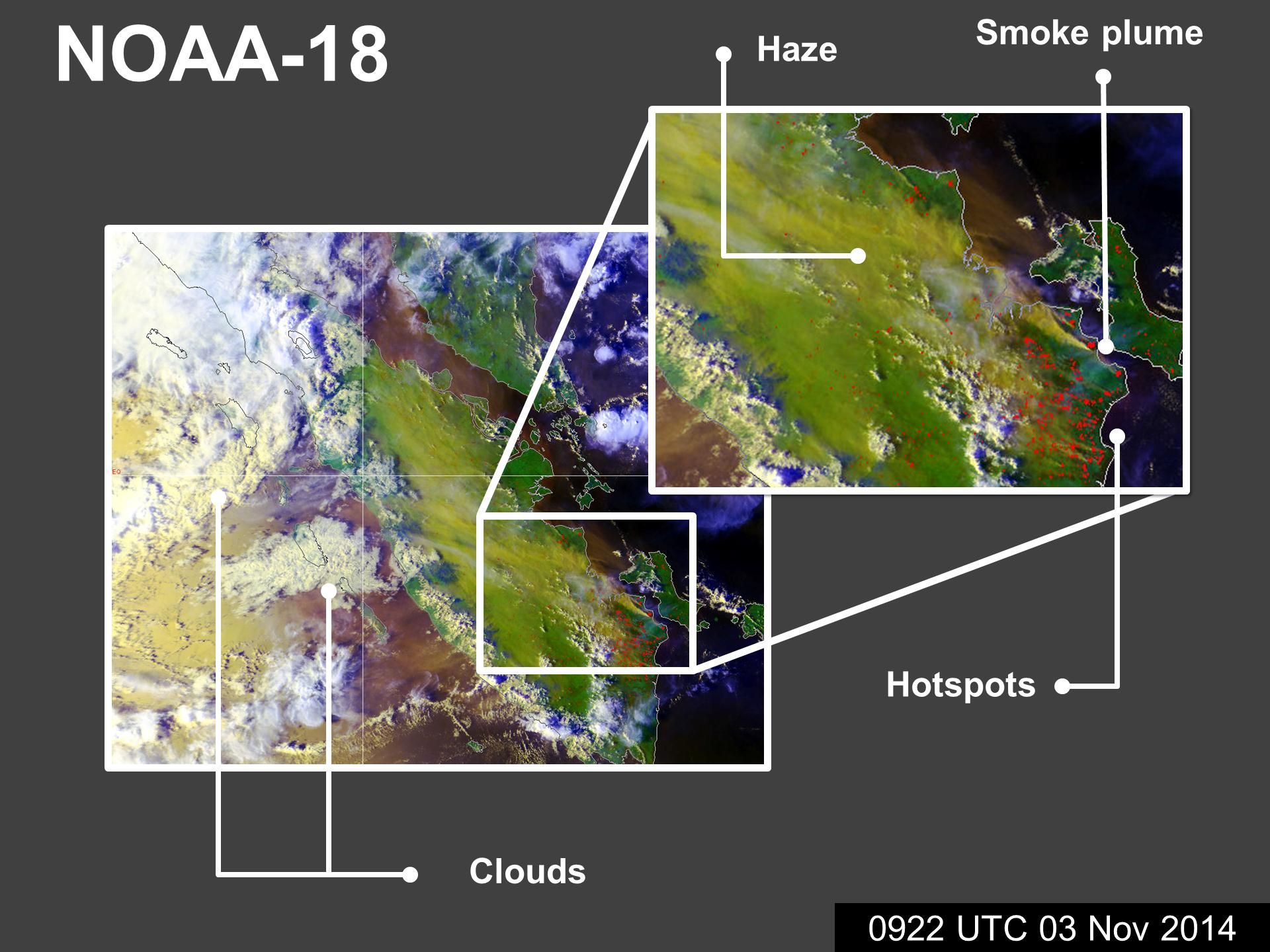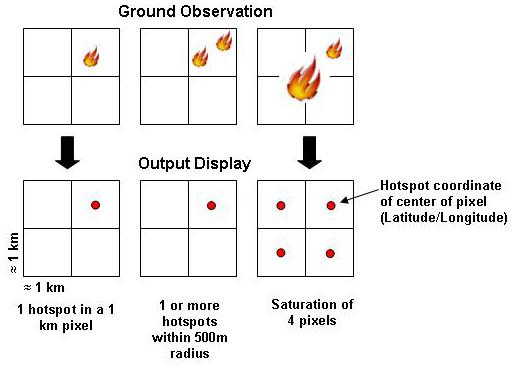Southeast Asia Regional Centre
WMO Vegetation Fire and Smoke Pollution
Warning and Advisory System (VFSP-WAS)
FAQ
How do we detect fires and smoke using satellites images and what are the limitations?
To help identify and highlight different features such as hotspots, smoke plumes/haze and clouds, the data from a combination of spectral channels are used to form a multi-spectral image.Three primary colours of red, green, blue (RGB) are assigned to selected spectral channels of NOAA, AQUA and TERRA satellites. In particular, the polar-orbiting satellite images that ASMC produces are based on the following colour-to-channel assignment.
| RED | Visible band |
| GREEN | Near-infrared (NIR) Band |
| BLUE | Long-wavelength Infrared (LWIR) Band |
Using this combination, hotspots are depicted in red, smoke plumes and haze in shades of yellow, and clouds in either white or blue-white. The colour assignment is not unique and various colour-to-channel combinations can be used which will result in the different features to be highlighted in a different colour.

Land and vegetated surfaces are strongly reflective in the NIR (green) channel spectral band, thus appearing green in the above image. Clouds can be seen in both visible and LWIR spectral bands, whereas smoke haze is normally not discernable in the IR band owing to their respective radiative properties. Therefore clouds appear white or bluish-white as it is detected by all RGB channels; smoke haze and plumes appear in shades of yellow as it is detected by only visible (red) and NIR (green). The texture of clouds is also different from that of smoke haze.
If the hotspot appears at the origin of a smoke plume, it is almost certain to be associated with an active fire. The smoke plumes will show a conical shape typical of fire emissions, with the vertex over the hot spots. Hot spots with no corresponding smoke plumes may be associated with very small scale fires or fires at the early stages of ignition.
There are limitations to the detection of smoke haze and hotspots. Overlying clouds will invariably obscure areas with smoke haze and hotspots. In the presence of low clouds or fog, the smoke detection technique may not succeed and differences in the shape and texture between smoke and cloud/fog will need to be considered. Strong reflection of sunlight can also give rise to yellowish shades and these are not related to haze.
How does the fire detection algorithm work?
Land fires on the ground emit spectral signals that are characterised by higher emissions of mid-infrared radiation. Such thermal anomalies are exploited by fire detection algorithms to determine whether a particular pixel observed by the satellite’s sensor is or is not associated with a forest fire.If a particular pixel is flagged to be a fire, it is indicated as a hotspot. The fire detection algorithm, also referred to as a contextual algorithm, compares the values of suspected fire pixels against a set of absolute thresholds, and with values of surrounding pixels.
Depending on the size and proximity of fires, they may or may not appear as separate hotspots. If the total size of fire detected is of sub-pixel size, it will appear as a single hotspot. As for active fires with size bigger than a pixel, they will appear as multiple hotspots.
It is important to note that a hotspot detected does not always correspond to actual land fires. Other high temperature bodies may also exhibit similar thermal properties as land fires. Examples are gas flares and power plants. The detection of a fire depends on a number of factors. Fires with short lifespan may have started and ended in between satellite passes. Situations which cause some hotspots and smoke haze to escape detection by satellites include cloud cover, fires below forest canopy, and the relative size and temperature of fires being insufficient to mark the fire as a hotspot.

What is Aerosol optical depth (AOD)?
AOD is a measure of the extinction of sunlight by atmospheric aerosol particles. These particles can be from dust, smoke or urban pollution, and can absorb or scatter sunlight. AOD is a dimensionless number which is related to the amount of aerosol particles in the the vertical column of atmosphere above the observing instrument (e.g., an AERONET sun-photometer). A value of 0.01 indicates an extremely clean atmosphere, while a value of 0.8 indicates hazy skies. AOD measurements during smoke haze episodes will usually exceed 1, and may even reach 3 in the most severe situations.
Can AOD tell us the type of aerosol particles that is in the atmosphere?
AOD cannot conclusively tell us what type of particles is in the atmosphere. A combination with other information from the sun-photometer is needed, such as Angstrom Exponent (AE) which is a measure of the dependency of AOD on wavelengths. A high AE of more than 1 indicates fine-mode particles dominating the atmosphere, such as those from forest fires or urban pollution, while a low AE of less than 1 indicates more coarse-mode particles such as dust or sea salt.

